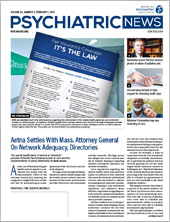Higher doses of antipsychotics raise the risk of death in youth aged 5 to 24 years who take the medications for conditions other than psychosis, when compared with those who take other psychiatric medications, according to a study in JAMA Psychiatry.
This underscores the need for vigilance in ensuring the most appropriate medications are prescribed for each condition, lead author Wayne Ray, Ph.D., a professor of health policy at Vanderbilt University in Nashville, Tenn., told Psychiatric News.
“More than one million children and young adults receive antipsychotics, and most of them are for conditions for which other treatments are available. They are dangerous and carry cardiovascular, respiratory, and metabolic risks,” Ray said.
In the study, Ray and his colleagues analyzed data from 247,858 patients who were enrolled in Tennessee’s Medicaid program between 1999 and 2014. Of those, 30,120 began taking high doses of antipsychotics (more than 50 mg chlorpromazine equivalents), 28,377 began taking low doses of antipsychotics (50 mg or less chlorpromazine equivalents), and 189,361 began taking other psychiatric medications including psychostimulants, antidepressants, and mood stabilizers (the control group).
Among all participants, 70.6 percent had a diagnosis of behavioral symptoms such as attention-deficit/hyperactivity disorder (ADHD), conduct disorder, or impulsivity. Only 28.1 percent in the high-dose group had diagnoses for which there is an FDA-approved indication for taking antipsychotics, such as bipolar disorder or autism spectrum disorder.
The researchers found that among patients without life-threatening somatic illness or psychosis who started antipsychotics, those in the high-dose group had an 80 percent increased risk of death, attributable to a 3.5-fold increase risk of unexpected deaths. After accounting for overdose, this increased risk for unexpected deaths persisted, with a 4.3-fold increased risk of death from cardiovascular or metabolic causes. Furthermore, when extrapolating the data out to death rates per 100,000 person-years, the researchers found a rate of 25.6 cardiovascular or metabolic deaths per 100,000 person-years in the high-dose group, compared with a rate of only 4.9 in the control group.
“The bottom line is that the findings reinforce existing guidelines for care and cautious use of antipsychotics in younger populations,” said Ray. He noted the need to consider other treatments, provide pretreatment evaluations, identify patients with cardiac problems that might compound their risk, and ensure post-treatment monitoring for cardiac, respiratory, and metabolic effects.
“These things are already in the recommendations, but we suspect that they are not followed in regular practice,” Ray said.
“Most [high-dose antipsychotics] aren’t prescribed by psychiatrists, and they are primarily written for behavioral symptoms and mood disorders for which there are other medications and psychosocial interventions,” Ray added.
John Newcomer, M.D., president and chief executive officer of South Florida Behavioral Network in Miami and an adjunct professor of psychiatry at Washington University School of Medicine in St. Louis, noted potential barriers to more appropriate prescribing of antipsychotics.
“The logistics, needed training, and reimbursement structure for effective behavioral therapies that include CBT [cognitive-behavioral therapy] all present barriers to their increased use. This in combination with the perceived simplicity of antipsychotic prescription and perceived demands from parents and schools for a rapid fix for certain disruptive behaviors may be what contributes to higher off-label use of antipsychotics in children in the United States,” said Newcomer, who was not involved in the research.
Ray agreed.
“Reimbursement drives medication over other approaches. We need options other than just trying to use medications. These [nonpsychotic] conditions are more complex than that. There are bad-home situations, the need for parental training, and other kinds of issues,” said Ray. “There are nonpharmacologic interventions that can work. Psychiatrists have long been frustrated by a lack of resources for these, but it’s a matter of life or death.”
This study was supported by the National Heart, Lung, and Blood Institute and the National Institute for Child Health and Human Development. ■
“Association of Antipsychotic Treatment With Risk of Unexpected Death Among Children and Youths” can be accessed
here.


